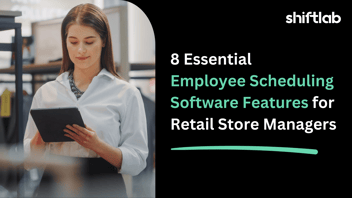
The Hidden Costs of a Poor Employee Schedule—And How to Fix Them
Your employee schedule might not seem important to your store’s budget, unlike other major cost drivers: inventory, rent, and payroll. But poor employee scheduling can quietly chip away at your bottom line.
Inconsistent staffing often leads to frustrating, last-minute shift changes. Those can lead to decreased productivity and missed sales opportunities during busy store periods.
Your schedule might be the culprit if your team’s performance feels off or your labor costs seem high without an apparent reason.
And you're not alone—many managers still rely on outdated employee scheduling techniques.
The good news is there's a better way forward. In this guide, we’ll show you a weak employee schedule and how to fix it in a few easy steps.
What Makes a Poor Employee Schedule?
An ineffective schedule comes with several key symptoms, including:
- Frequent last-minute schedule changes
- High no-show or call-out rates
- Low employee morale
- Unnecessary overtime or overstaffing during slow times
- Understaffing and poor customer service during busy periods
Weak employee schedules usually happen for one main reason: manual scheduling using outdated tools like Excel.
These systems don’t offer real-time visibility into your store's traffic patterns. They don't provide labor forecasting. They don’t recognize high performers. They don't allow managers to optimize shifts.
This means it's almost impossible for managers to build balanced and optimized schedules.
The Hidden Costs of Bad Scheduling
The consequences of a poor employee schedule are clear.
Inconsistent hours mean employees get unpredictable shift times. This makes it hard for them to plan their personal lives, arrange childcare, or manage second jobs.
The uncertainty can cause employees to feel they aren't valued at your store, leading to higher turnover and all the associated costs.
A simple, Excel-based schedule fails to consider demand, which can mean your employees are often overworked—or bored.
Overworked because too few staff members get scheduled during peak times, and bored because too many are on during slow times.
Both of these situations can cost your store money.
Worse, these inefficiencies create extra work for managers, who spend hours on last-minute fixes instead of leading teams or improving operations.
A high customer-to-staff ratio can mean long wait times, disgruntled shoppers, and missed sales.
A high staff-to-customer ratio means you’re paying for more labor than necessary, wasting budget on idle time.
The good news is that avoiding these hidden yet significant costs of bad scheduling is easier than you think.
Scheduling Best Practices That Save Time and Money
Now that we've established how a poor employee schedule can hurt your team and your store, it's time to look at solutions.
These employee scheduling best practices can help turn your schedule around.
1. Forecast your store's demand before building schedules
These days, there’s no reason not to use technology to improve…well, everything in life.
This applies to your retail store, too. You can use historical sales and foot traffic data to predict busy and slow periods. This helps prevent overstaffing and understaffing—major contributors to unnecessary labor costs.
2. Cross-train your staff across different departments
When employees can perform multiple roles, your team gains flexibility. This makes filling last-minute gaps in the schedule easier without sacrificing coverage or service quality.
Cross-training also prevents bottlenecks during peak hours and helps avoid overworking the same team members.
Plus, it keeps staff engaged by building new skills and offering variety in their daily work.
3. Create predictable, repeatable shift patterns employees can depend on
Inconsistent schedules lead to low morale and poor employee retention.
According to research published in the Journal of Manufacturing & Service Operations Management, even small amounts of shift volatility can significantly impact retention.
The study found that “30 days of high schedule volatility over the year increases the average worker’s probability of quitting that year by 20%.”
This is why consistent scheduling is so valuable. It helps staff plan their personal lives without extra stress, leading to higher satisfaction, fewer no-shows, and improved retention.
4. Build schedules in advance
Avoid making frequent, last-minute changes to your schedule. As established in the Journal of Manufacturing & Service Operations Management, these sudden changes stress out your employees, hurt productivity, and can even lead to high turnover.
Instead, make it a habit to publish schedules at least two weeks ahead. The easier it is for your team to plan their lives around their work schedule, the better. Plus, it shows you value them as people with full, rich lives outside of work—not just as employees.
5. Track employee availability and preferences
Employees should have a say in when and where they work. One way to improve your employee schedule is to involve staff in the scheduling process.
This is easier to do now than ever before. Modern tools can capture employee availability and manage time-off requests for you, all while keeping things fair (and compliant!) for everyone on the team.
Paying attention to each employee’s preferences goes a long way in strengthening your schedule.
How Smart Tools Can Help: A Shiftlab Spotlight
At Shiftlab, we help retailers, store managers, and business owners create schedules that make everyone happy. We aim to make it easy for you to follow the best practices for employee scheduling outlined above.
Here’s how our employee schedule maker can help.
- AI-powered scheduling: Shiftlab automatically creates optimized schedules based on sales data, peak hours, and employee performance. This reduces guesswork and ensures your store always has the correct number of people on shift.
- Performance-based shift planning: Shiftlab uses performance metrics to ensure top employees are on during high-impact hours. This gives newer employees time to improve their skills in lower-impact shifts.
- Employee availability input. Employees can set their availability, preferences, and time-off requests through our employee shift scheduling app. This helps reduce scheduling conflicts and no-shows and considers your team's personal lives.
- Mobile app for employees and managers. Our mobile-friendly employee scheduling app keeps everyone connected, informed, and in control.
- Open shifts and shift swap tools. Your staff can pick up or swap shifts directly within our employee shift schedule app. This improves your flexibility and shift coverage without putting extra strain on managers.
Ready to transform your scheduling? Here’s how to get started.
Your Step-by-Step Plan to Improve Employee Scheduling
Improving your employee schedule doesn’t have to be overwhelming. Follow these four easy steps to create a more efficient and employee-friendly scheduling process:
Step 1: Audit your current process
Look at your existing scheduling system. Are shifts being fairly filled? Are employees getting their schedules late—as in right before the workweek in question? Identify where your store's productivity is decreasing, where gaps exist, and where costs are creeping up.
Step 2: Implement basic best practices
Start small by making small, measurable changes from our list of employee scheduling techniques. Set scheduling rules use shift templates, and plan schedules at least two weeks in advance. Encourage employees to submit their availability early to avoid conflicts.
Step 3: Choose a tool like Shiftlab
Manual systems can only take you so far. Use an intelligent employee schedule maker like Shiftlab to make your life (much) easier. Shiftlab can help you automate and optimize your scheduling while keeping your team happy and in control via our employee shift schedule app.
Step 4: Gather feedback and adjust
Collect input from staff and managers after implementing your new and improved employee schedule. Look at performance metrics and shift coverage. Adjust your strategy based on what’s working—and what’s not.
Smarter Scheduling with Shiftlab
Poor scheduling drives up costs, lowers morale, and hurts productivity.
But the good news? It’s completely fixable.
All you have to do is adopt smarter employee scheduling techniques and use the right tools. That way, you can streamline your operations and support a happier, more reliable team.
You don’t need to guess or stress. Shiftlab takes the complexity out of scheduling with automation, real-time data, and employee-friendly features.
Ready to build better employee schedules? Book a demo with Shiftlab today and see the difference intelligent employee scheduling can make.
Frequently Asked Questions
What are the consequences of poor scheduling?
Poor scheduling leads to high employee turnover, decreased productivity, and inflated labor costs.
It also affects customer service. When shifts are understaffed, overwhelmed employees can't keep up with customer needs.
At the same time, you could unintentionally overschedule shifts that aren't actually all that busy at all. This leads to boring shifts for employees—and wasted labor for your organization.
How do you solve a scheduling problem?
Start by identifying where your current schedule falls short. A full audit, or even a quick one, can show you a lot about your employee schedule.
Are shifts being filled fairly, or are there frequent call-outs? Do employees feel satisfied with when and where they get the schedule, or do they seem frustrated and stressed?
Once you know more about the holes in your schedule, it's time to apply some employee scheduling best practices. These can include everything from forecasting demand to collecting employee availability in advance.
Finally, using a tool like Shiftlab makes everything about implementing employee scheduling techniques easier. With our employee schedule maker, you can easily automate and optimize your schedule.
What is a scheduling strategy?
A scheduling strategy is a structured, goal-oriented approach to assigning shifts. It ensures coverage aligns with business demand while respecting employee preferences.
A good strategy uses tools, templates, and forecasting to build fair, consistent, cost-effective schedules.
%201.png?width=564&height=119&name=Shiftlab_Logo%20(Black)%201.png)



